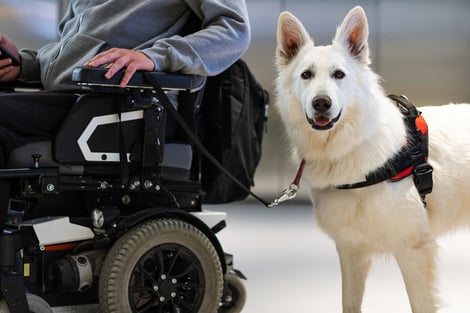Learning the Difference between an Emotional Support vs. Service Animal

For many people, an animal is a cherished companion who lives with us, providing comfort and offering many physical and mental health benefits.
Other animals perform extra duties and help to keep people healthy and safe.
Are you a pet parent who is confused about the difference between an emotional support animal and a service animal? And what is a therapy animal?
Do you know the laws regarding housing, travel, and other access for animals?
Let’s start by defining the terms.
Service Animals
The American Veterinary Medical Association (AVMA) defines service animals as follows:
“Service animals are animals trained to assist people with disabilities in the activities of normal living. The Americans with Disabilities Act (ADA) defines service animals as “...any...dog (or miniature horse) individually trained to do work or perform tasks for the benefit of an individual with a disability... Examples of work or tasks include, but are not limited to, assisting individuals who are blind or have low vision with navigation and other tasks, alerting individuals who are deaf or hard of hearing to the presence of people or sounds, providing non‑violent protection or rescue work, pulling a wheelchair, assisting an individual during a seizure, alerting individuals to the presence of allergens, retrieving items such as medicine or the telephone, providing physical support and assistance with balance and stability to individuals with mobility disabilities, and helping persons with psychiatric and neurological disabilities by preventing or interrupting impulsive or destructive behaviors. The crime deterrent effects of an animal’s presence and the provision of emotional support, well‑being, comfort, or companionship do not constitute work or tasks for the purposes of this definition.”
A couple of key points from that paragraph are that an individual with a service dog has to have a disability as defined by the ADA, and the animal must be trained to do specific tasks that relate to the disability.
So, if the dog or miniature horse provides other important help, such as emotional support, but is not trained for a task specific to an ADA‑defined disability, then they are not a service animal.
Emotional Support Animals
There’s one significant difference between a service animal and an emotional support animal. The ADA’s definition of a service animal only includes dogs and miniature horses, but any animal can be designated an emotional support animal (ESA). That’s why you might be familiar with stories of people trying to bring emotional support llamas or birds onto airplanes.
But you can’t just decide your pet is an emotional support animal. A qualified doctor or mental health professional (usually a therapist or psychiatrist) needs to generate a “prescription” for an emotional support animal.
If you Google “How do I get an emotional support animal?” you’ll find many ways to get assessed and certified online. Some of these sites are legitimate, and others are scams. Beware of sites that promise easy ways to get emotional support animal letters. A legally enforceable ESA letter is based on a live or online consultation with a licensed mental health professional—not just an online quiz. I wish these scammers that claim to provide such documentation would go out of business because they rely on people’s confusion to make money rather than doing a good deed for people and their pets.
Unfortunately, some people use these scam ESA letters to get around travel or housing rules, which creates a risk for those who have a prescribed need for an emotional support animal. Traveling with pets should be done only when absolutely necessary and within the law. Housing rules should change to better accommodate the estimated 80% of households with pets, without risking the health and welfare of others in the building or damage to the property.
The list of conditions that can qualify someone to have an ESA are anxiety, depression, learning disabilities, attention deficit disorder, chronic stress, and post‑traumatic stress disorder.
Unlike service dogs, emotional support animals do not require any training or licensing. That doesn’t mean they’re not helping, of course. People who struggle with mental illness often report that petting or holding their animals helps them feel less anxious and lonely.
Therapy Animals
Like ESAs, therapy animals come in many species, but dogs are the most common.
They are trained to provide emotional support and comfort to people other than their owners. Friendly, well‑behaved dogs are perfect for this job!
Sometimes therapy dogs visit schools, hospitals, nursing homes, rehab centers, or other institutions, or they can be connected with a psychotherapy practice. If you hear about school kids or prisoners reading to dogs, they are probably therapy dogs.
Therapy animals need to be evaluated by veterinarians and trained by an animal‑assisted intervention organization. Sometimes their owners handle them, and other times they have a professional handler.
But they are not recognized by federal law under the ADA.
That means therapy animals don’t have a protected right of access to public facilities like service animals do. It is up to the management whether to allow a therapy dog into a space. Usually, a therapy dog will wear a bandana, harness, or ID tag.
Rules on Restaurants, Housing, and Travel
Are you wondering whether your animal can join you in a public space, live in housing with a “no pets” policy, or fly with you on an airplane?
AVMA publishes a handy poster that helps people understand how the rules apply to service animals, emotional support animals, and therapy animals.
This infographic should clear up any confusion you may have about the differences between emotional support animals, service animals, and therapy animals. If not, read below.
Service Animals
In short, the only animals that are legally protected in these situations are service animals. Because they are recognized under the ADA, they can go with their owner to any place where the public is allowed. They can live with their owners, even if the housing has a “no pets” policy, and they can join people on an airplane for no additional charge.
Emotional Support Animals
The only accommodation allowed for emotional support animals is that they can live with their owners in “no pet” housing. And remember, the person needs a letter from a licensed human health professional declaring the animal is an ESA.
Therapy Animals
Therapy animals can visit facilities like schools and nursing homes if they are invited by the management. But therapy animals don’t have the legal protection to go to restaurants or stores, fly on airplanes without a ticket, or live in housing with “no pets” policies.
A Range of Support
Whether you have a service animal, an emotional support animal, or a therapy animal, these creatures are definitely making life better for humans.
And understanding the legal differences can help you avoid tricky situations when you try to board a plane, enter a restaurant, or rent an apartment.
When we have a shared understanding of the roles of different helper animals, they can continue their important work.

